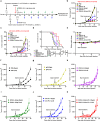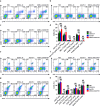Enhanced anti-melanoma efficacy through a combination of the armed oncolytic adenovirus ZD55-IL-24 and immune checkpoint blockade in B16-bearing immunocompetent mouse model
- PMID: 33903973
- PMCID: PMC8571158
- DOI: 10.1007/s00262-021-02946-z
Enhanced anti-melanoma efficacy through a combination of the armed oncolytic adenovirus ZD55-IL-24 and immune checkpoint blockade in B16-bearing immunocompetent mouse model
Abstract
Although the recent treatment in melanoma through the use of anti-PD-1 immunotherapy is successful, the efficacy of this approach remains to be improved. Here, we explore the feasibility of combination strategy with the armed oncolytic adenovirus ZD55-IL-24 and PD-1 blockade. We find that combination therapy with localized ZD55-IL-24 and systemic PD-1 blockade leads to synergistic inhibition of both local and distant established tumors in B16-bearing immunocompetent mouse model. Our further mechanism investigation reveals that synergistic therapeutic effect is associated with marked promotion of tumor immune infiltration and recognition in both local and distant tumors as well as spleens. PD-1 blockade has no obvious effect on promotion of tumor immune infiltration and recognition. Localized therapy with ZD55-IL-24, however, can help PD-1 blockade to overcome the limitation of relatively low tumor immune infiltration and recognition. This study provides a rationale for investigation of such combination therapy in the clinic.
Keywords: Combination therapy; Melanoma; Oncolytic virus; PD-1 blockade; Tumor immune infiltration; Tumor immune recognition.
© 2021. The Author(s).
Conflict of interest statement
X.-Y.L., J.-F.G. and L.-Y.S. are inventors on a patent for the construction and application of ZD55-IL-24 (US Patent and Trademark Office, 20090117643A1). The other authors declare no competing financial interests.
Figures







Similar articles
-
The armed oncolytic adenovirus ZD55-IL-24 eradicates melanoma by turning the tumor cells from the self-state into the nonself-state besides direct killing.Cell Death Dis. 2020 Nov 30;11(11):1022. doi: 10.1038/s41419-020-03223-0. Cell Death Dis. 2020. PMID: 33257647 Free PMC article.
-
Optimization of the Administration Strategy for the Armed Oncolytic Adenovirus ZD55-IL-24 in Both Immunocompromised and Immunocompetent Mouse Models.Hum Gene Ther. 2021 Dec;32(23-24):1481-1494. doi: 10.1089/hum.2021.036. Epub 2021 Jul 28. Hum Gene Ther. 2021. PMID: 34155929
-
A dual-functional oncolytic adenovirus ZD55-aPD-L1 scFv armed with PD-L1 inhibitor potentiates its antitumor activity.Int Immunopharmacol. 2024 Feb 15;128:111579. doi: 10.1016/j.intimp.2024.111579. Epub 2024 Jan 25. Int Immunopharmacol. 2024. PMID: 38278066
-
Combining Tumor Vaccination and Oncolytic Viral Approaches with Checkpoint Inhibitors: Rationale, Pre-Clinical Experience, and Current Clinical Trials in Malignant Melanoma.Am J Clin Dermatol. 2018 Oct;19(5):657-670. doi: 10.1007/s40257-018-0359-4. Am J Clin Dermatol. 2018. PMID: 29961183 Review.
-
Evolving Status of Clinical Immunotherapy with Oncolytic Adenovirus.Clin Cancer Res. 2021 Jun 1;27(11):2979-2988. doi: 10.1158/1078-0432.CCR-20-1565. Epub 2021 Feb 1. Clin Cancer Res. 2021. PMID: 33526422 Review.
Cited by
-
Oncolytic viruses combined with immune checkpoint therapy for colorectal cancer is a promising treatment option.Front Immunol. 2022 Jul 15;13:961796. doi: 10.3389/fimmu.2022.961796. eCollection 2022. Front Immunol. 2022. PMID: 35911673 Free PMC article. Review.
-
Improving cancer immunotherapy by rationally combining oncolytic virus with modulators targeting key signaling pathways.Mol Cancer. 2022 Oct 12;21(1):196. doi: 10.1186/s12943-022-01664-z. Mol Cancer. 2022. PMID: 36221123 Free PMC article. Review.
-
Enhanced Cancer Therapy Using an Engineered Designer Cytokine Alone and in Combination With an Immune Checkpoint Inhibitor.Front Oncol. 2022 Mar 24;12:812560. doi: 10.3389/fonc.2022.812560. eCollection 2022. Front Oncol. 2022. PMID: 35402258 Free PMC article.
-
Synergy of oncolytic adenovirus and immune checkpoint inhibitors: transforming cancer immunotherapy paradigms.Front Immunol. 2025 Jul 8;16:1610858. doi: 10.3389/fimmu.2025.1610858. eCollection 2025. Front Immunol. 2025. PMID: 40698086 Free PMC article. Review.
-
Interleukin-24: A Multidimensional Therapeutic for Treatment of Human Diseases.Wiley Interdiscip Rev Nanomed Nanobiotechnol. 2025 May-Jun;17(3):e70013. doi: 10.1002/wnan.70013. Wiley Interdiscip Rev Nanomed Nanobiotechnol. 2025. PMID: 40338095 Free PMC article. Review.
References
-
- Moynihan KD, Opel CF, Szeto GL, Tzeng A, Zhu EF, Engreitz JM, Williams RT, Rakhra K, Zhang MH, Rothschilds AM, Kumari S, Kelly RL, Kwan BH, Abraham W, Hu K, Mehta NK, Kauke MJ, Suh H, Cochran JR, Lauffenburger DA, Wittrup KD, Irvine DJ. Eradication of large established tumors in mice by combination immunotherapy that engages innate and adaptive immune responses. Nat Med. 2016;22(12):1402–1410. doi: 10.1038/nm.4200. - DOI - PMC - PubMed
MeSH terms
Substances
Grants and funding
- 81372453/National Natural Science Foundation of China
- 81572999/National Natural Science Foundation of China
- 31701220/National Natural Science Foundation of China
- 2013ZZ0004/Sichuan Province Science and Technology Support Program
- Y363S21763/Shanghai Institutes for Biological Science, Chinese Academy of Sciences and Sichuan Huiyang Life Science and Technology Corp. Research Program
LinkOut - more resources
Full Text Sources
Medical

